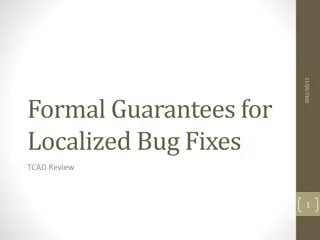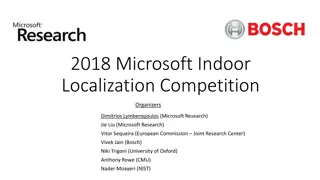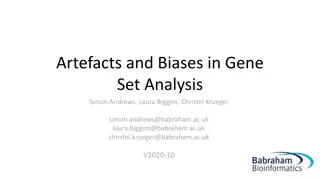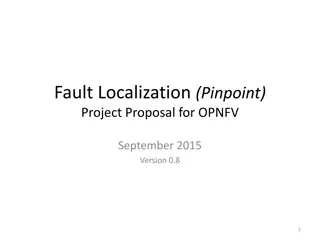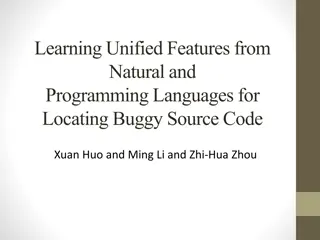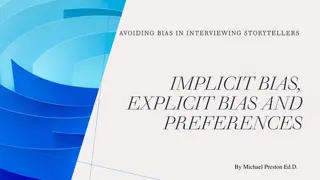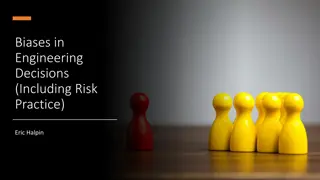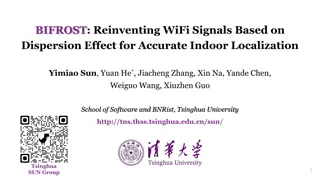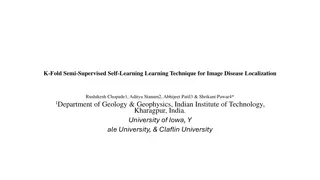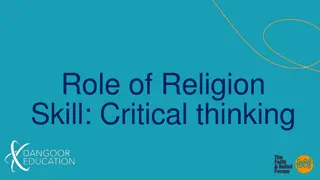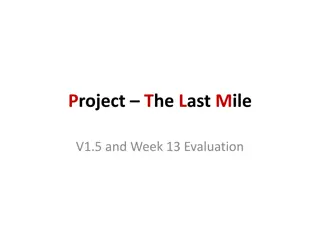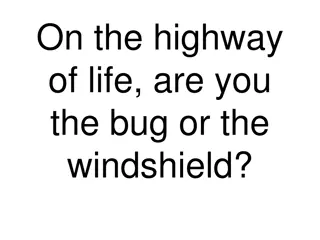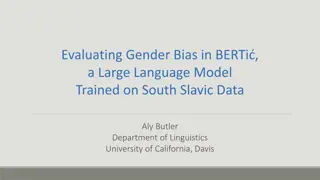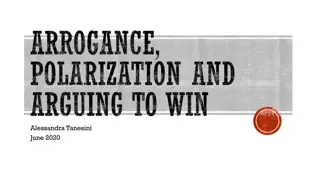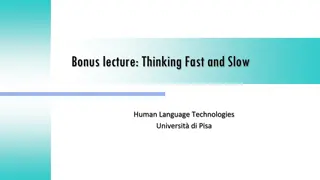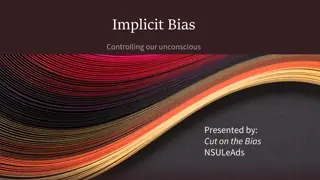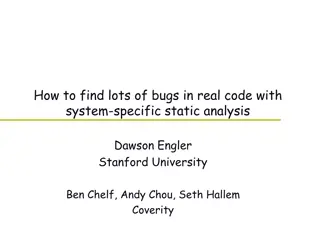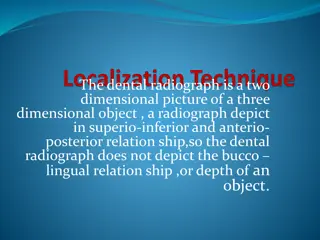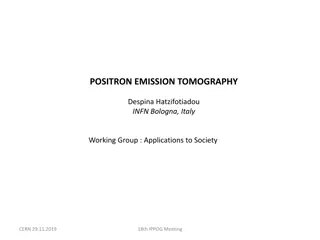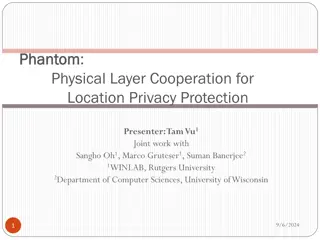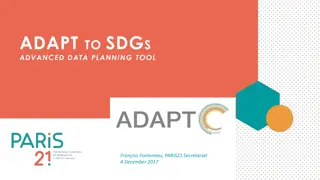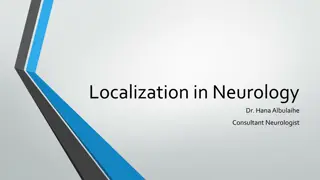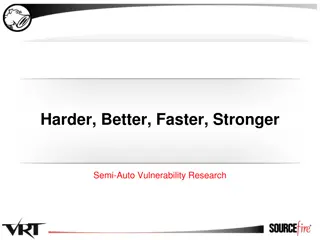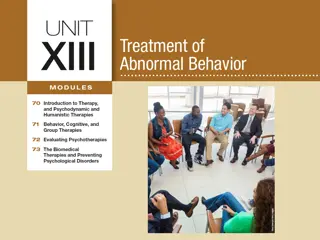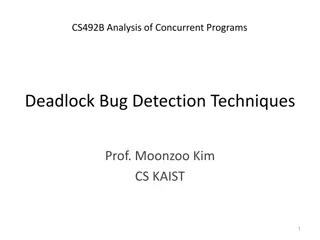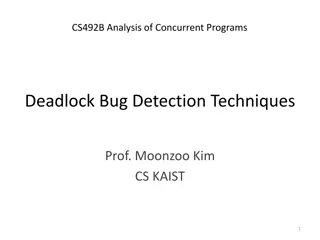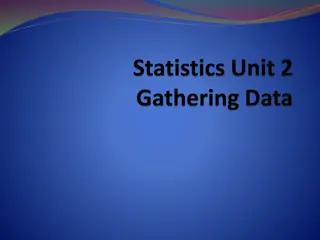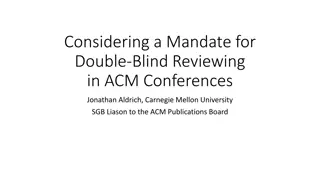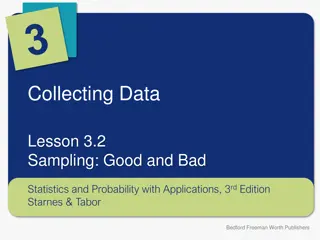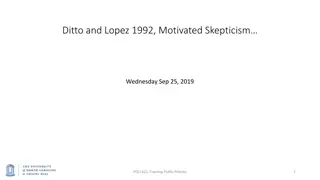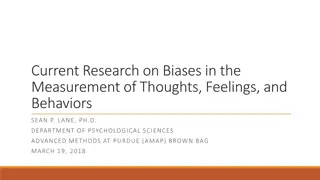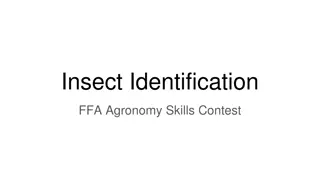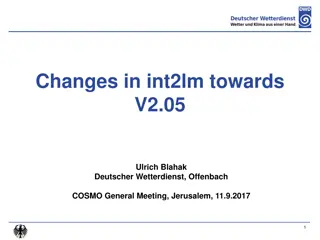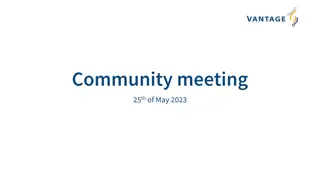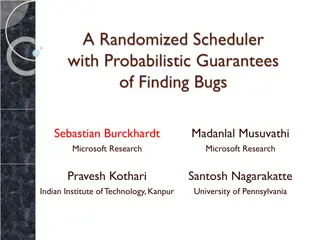Investigating Biases in Bug Localization Studies: A Critical Analysis
This research delves into potential biases affecting bug localization studies in software development. It explores misclassification of bug reports, pre-localized reports, and issues with ground truth files, shedding light on the challenges in accurately predicting and localizing software bugs.
Download Presentation

Please find below an Image/Link to download the presentation.
The content on the website is provided AS IS for your information and personal use only. It may not be sold, licensed, or shared on other websites without obtaining consent from the author. Download presentation by click this link. If you encounter any issues during the download, it is possible that the publisher has removed the file from their server.
E N D
Presentation Transcript
ASE '14 Proceedings of the 29th ACM/IEEE international conference on Automated software engineering (Pages 803-814 ) Vasteras, Sweden September 15 - 19, 2014 G201892006
Index - Introduction - Related Work - Bias 1 : Report Misclassification - Bias 2 : Localized Bug Reports - Bias 3 : Non-Buggy Files - Other Findings and Threats - Conclusion and Futurework
Introduction - Issue tracking systems, which contains information related to issues faced during the development as well as after the release of a software project, is an integral part of software development activity. - These techniques often use standard information retrieval (IR) techniques to compute the similarity between the textual description of bug report and textual description of source code. - Past studies indicate that the performance of these techniques are promising - up to 80% of bug reports can be localized by just inspecting 5 source code Files. - Despite the promising results of IR-based bug localization approaches, a number of potential biases can affect the validity of results reported in prior studies. - In this work, we focus on investigating three potential biases.
Introduction 1. Wrongly Classified Reports. - Herzig et al. reported that many issue reports in issue tracking systems are 803 wrongly classified. - About one third of all issue reports marked as bugs are not really bugs. - Herzig et al. have shown that this potential bias significantly affects bug prediction studies that predict whether a file is potentially buggy or not based on the history of prior bugs. - This potential bias might affect bug localization studies too as the characteristics of bug reports and other issues, e.g., refactoring requests, can be very different.
Introduction 2. Already Localized Reports. - Our manual investigation of a number of bug reports find that the textual descriptions of many reports have already specified the files that contain the bug. - These localized reports do not require bug localization approaches.
Introduction 3. Incorrect Ground Truth Files. - Kawrykow and Robillard reported that many changes made to source code files are non- essential changes. - These nonessential changes include cosmetic changes made to source code which do not affect the behavior of systems. - Past fault localization studies often use as ground truth source code files that are touched by commits that fix the bugs. - However, no manual investigation was done to check if these files are affected by essential or non-essential changes. - Files that are affected by non-essential changes should be excluded from the ground truth files as they do not contain the bug.
Introduction RQ1: What are the effects of wrongly classified issue reports on bug localization? RQ2: What are the effects of localized bug reports on bug localization? RQ3: What are the effects of wrongly identified ground truth files on bug localization? - We investigate 5,591 issue reports stored in issue tracking systems of three projects
Introduction The contributions of this paper are as follows: 1. We extend our preliminary study, to analyze the effect of wrongly classified issue reports on the effectiveness of bug localization tools. 2. We analyze the effect of localized bug reports on the effectiveness of bug localization tools. We also build an automated technique that can categorize bug reports into these three categories with high accuracy. 3. We analyze the effect of incorrect ground truth files on the effectiveness of bug localization tools. 4. We release a clean dataset that researchers can use to evaluate future bug localization techniques.
Related Work - Many software engineering studies are highly dependent on data stored in software repositories. - However, the dataset is not always clean, which means it might contain bias. - A set of research work have shown that such bias in a dataset might impact software engineering studies. - We highlight some of them especially closely related ones below. - In the previous work, we find that bias 1 significantly impacts bug localization results. - In this study, we find that bias 1 only significantly impacts bug localization results for one out of the three projects. - The other two research questions are newly proposed in this work.
Related Work - There are many IR-based bug localization approaches that retrieve source code files that are relevant to an input bug report - In this work, we focus on potential biases that might impact bug localization techniques. - Our study highlights several steps that researchers need to take to clean up datasets used to evaluate the performance of bug localization techniques.
Bias 1 REPORT MISCLASSIFICATION
Bias 1 : Report Misclassification - Issue tracking systems contain reports of several types of issues such as bugs, requests for improvement, documentation, refactoring, etc. - Herzig et al. report that a substantial number of issue reports marked as bugs, are not bugs but other kinds of issues. - Their results show that these misclassifications have a significant impact on bug prediction.
Bias 1 : Report Misclassification Step1. Data Acquisition - We use Herzig et al.'s dataset of manually analyzed issue reports - We download the issue reports from the associated JIRA repositories and extract the textual contents of the summary and description of the reports. - We use the git version control system of the projects to get the commit log files, which are used to map issue reports to their corresponding commits. - We use these mapped commits to check out the source code files prior to the commits that address the issue and the source code files when the issue is resolved. - For each source code file, we perform a similar preprocessing step to represent a file as a bag- of-words.
Bias 1 : Report Misclassification Step2. BugLocalization - After the data acquisition, we have the textual content of the issue reports, the textual content of each source code file in the revision prior to the fix, and a set of ground truth files that are changed to fix the issue report. - We give the textual content of the issue reports and the revision's source code files as input to the bug localization technique, which outputs a ranked list of files sorted based on the similarity to the bug report.
Analyzing Structured Source File Information (VSM) VSM : In Vector Space Model (VSM), each document is expressed as a vector of token weights typically computed as a product of token frequency and inverse document frequency of each token. Cosine similarity is widely used to determine how close the two vectors are.
Bias 1 : Report Misclassification Step3. Effectiveness Measurement & Statistical Analysis. - After Step 2, for each issue report, we have a ranked list of source code files and a list of supposed ground truth files. - We compare these two lists to compute the average precision score. (MAP)
Bias 1 : Report Misclassification - We divide the issue reports into two categories: issue reports marked as bugs in the tracking system (Reported) and issue reports that are actual bugs i.e., manually labeled by Herzig et al. (Actual). - We compute the MAP scores and use Mann-Whitney U test to examine the difference between these two categories at 0.05 significance level. - We use Cohen's d to measure the effect size, which is the standardized difference between two means. - To interpret the effect size, we use the interpretation given by Cohen, i.e., d < 0.2 means trivial, 0.20 <= d < 0.5 means small, 0.5 <= d < 0.8 means medium, 0.80 <= d < 1.3 means large, and d >= 1.3 means very large.
Bias 1 : Report Misclassification - We divide the issue reports into two categories: issue reports marked as bugs in the tracking system (Reported) and issue reports that are actual bugs i.e., manually labeled by Herzig et al. (Actual). d < 0.2 means trivial
Bias 2 LOCALIZED BUG REPORTS
Bias 2 : Localized Bug Reports - Localized bug reports are those whose buggy files have been identified in the report itself. - For these reports, the remaining task to resolve the bug is simply to fix the buggy files. - These bug reports do not benefit or require bug localization solutions. - We start by manual investigating of a smaller subset of bug reports and identify localized ones. - We then developed an automated means to Find localized bug reports so that our analysis can scale to a larger number of bug reports. - Finally, we input these reports to a number of IR-based bug localization tools to investigate whether localized reports skew the results of bug localization tools.
Bias 2 : Localized Bug Reports Step 1: Manually Identifying Localized Bug Reports. - We manually analyzed 350 issue reports that "Herzig et al." labeled as bug reports. - Out of the 5,591 issue reports from the three projects, "Herzig et al." labeled 1,191 of them as bug reports. - We randomly selected these 350 from the pool of bug reports from the three software projects. - For our manual analysis, we read the summary and description Fields of each bug report. - We also collected the corresponding Files changed to Fix each bug. - We classified each bug report into one the three categories shown in Table 5.
Bias 2 : Localized Bug Reports Step 1: Manually Identifying Localized Bug Reports.
Bias 2 : Localized Bug Reports Step 2: Automatic Identification of Localized Reports. - In this step, we build an algorithm that takes in a set of files that are changed in bug fixing commits and a bug report, and outputs one of the three categories described in Table 5. - Our algorithm first extracts the text that appear in the summary and description fields of bug reports. - Next, it tokenizes this text into a set of word tokens. - Finally, it checks whether the name of each buggy file (ignoring its filename extension) appears as a word token in the set. - If all names appear in the set, our algorithm categorizes the report as fully localized. - If only some of the names appears in the set, it categorizes the bug report as partially localized. - Otherwise, it categorizes the bug report as not localized. - We have evaluated our algorithm on the 350 manually labeled bug reports and find that its accuracy is close to 100%.
Bias 2 : Localized Bug Reports Step 2: Automatic Identification of Localized Reports.
Bias 2 : Localized Bug Reports Step 2: Automatic Identification of Localized Reports.
Bias 2 : Localized Bug Reports Step 3 & Step 4 Step 3: Application of IR-Based Bug Localization Techniques. - After localized, partially localized, and not localized reports are identified, we create three groups of bug reports. Step 4: Statistical Analysis. - First, we compare the average precision scores achieved by VSM-based bug localization tool for the set of fully localized, partially localized, and not localized reports using Mann-Whitney-Wilcoxon test at 5% significance level. - We also compute Cohen's d on the average precision scores to see if the effect size is small, medium or large. - Second, we compare a subset of bug reports where the VSM-based bug localization technique performs the best and another subset where the VSM-based bug localization techniques performs the worst. - We then compare the distribution of fully, partially, and not localized bugs in these two subsets.
Bias 2 : Localized Bug Reports 0.5 <= d < 0.8 means medium, 0.80 <= d < 1.3 means large
Bias 2 : Localized Bug Reports - Bias 2, which is localized bug reports, significantly and substantially impacts bug localization results. - More than 50% of the bugs are (already) localized either fully or partially; these reports explicitly mention some or all of the files that are buggy and thus do not require a bug localization algorithm. - The mean average precision scores for fully and partially localized bug reports are much higher (i.e., significantly and substantially higher) than those for not localized bug reports. - The effect sizes of average precision scores between fully and not localized bug reports are large for all three projects.
Bias 3 NON-BUGGY FILES
Bias 3 : Non-Buggy Files - Another issue which can bias the result is wrongly identified ground truth files. - In past studies, wrongly identified ground truth files have not been removed since they require additional analysis. - These wrongly identified ground truth files can potentially skew the result of existing bug localization solutions.
Bias 3 : Non-Buggy Files Step 1: Manually Identifying Wrong Ground Truth Files. - We randomly select 100 bug reports that are not (already) localized (i.e., these reports do not explicitly mention any of the buggy files) and investigate the files that are modified in the bug fixing commits. - Files that are only affected by cosmetic changes, refactorings, etc. are considered as non-buggy files. - Based on this manual analysis, for each bug report we have the set of clean ground truth files and another set of dirty ground truth files. - "Thung et al." have extended Kawrykow and Robillard work to automatically identify real ground truth files. - However the accuracy of their proposed technique is still relatively low (i.e., precision and recall scores of 76.42% and 71.88%). - Hence, we do not employ any automated tool to identify wrong ground truth files.
Bias 3 : Non-Buggy Files Step 1: Manually Identifying Wrong Ground Truth Files. - We randomly select 100 bug reports that are not (already) localized (i.e., these reports do not explicitly mention any of the buggy files) and investigate the files that are modified in the bug fixing commits. - Files that are only affected by cosmetic changes, refactorings, etc. are considered as non-buggy files. - Based on this manual analysis, for each bug report we have the set of clean ground truth files and another set of dirty ground truth files. - "Thung et al." have extended Kawrykow and Robillard work to automatically identify real ground truth files. - However the accuracy of their proposed technique is still relatively low (i.e., precision and recall scores of 76.42% and 71.88%). - Hence, we do not employ any automated tool to identify wrong ground truth files.
Bias 3 : Non-Buggy Files Step 2 & Step 3 Step 2: Application of IR-Based Bug Localization Techniques. - After the set of clean and dirty ground truth files are identified for each of the 100 bug reports, we input the 100 bug 809 reports to a VSM-based bug localization tool. - We evaluate the results of the tool on dirty and clean ground truth files. Step 3: Statistical Analysis. - We compare the average precision scores achieved by the VSM-based bug localization tool for the 100 bug reports with clean and dirty ground truth files using Mann-Whitney-Wilcoxon test at 5% significance level. - We also compute Cohen's d on the average precision scores to see if the effect size is small, medium or large.
Bias 3 : Non-Buggy Files - We found that out of 498 files changed to fix the 100 bugs, only 358 files are really buggy. - The other 140 files (28.11 %) do not contain any of the bugs but are changed because of refactorings, modications to program comments, due to changes made to the buggy files, etc.
Bias 3 : Non-Buggy Files d < 0.2 means trivial - Bias 3, which is incorrect ground truth files, neither significantly nor substantially affects bug localization re- sults. - We notice that 28.11% of the files present in the ground truth (i.e., they are changed in a commit that fix a bug) are non-buggy. - Also, there is a difference of 0-0.036 between the MAP scores when a bug localization tool is evaluated on dirty and clean ground truth.
Other Evaluation Metrics - top-N-Rank (HIT@N) - MRR (Mean Reciprocal Rank) Bias 1 : Report Misclassification
Other Evaluation Metrics Bias 2 : Localized Bug Reports - Bias 3 : Non-Buggy Files
Threats to Validity - Threats to internal validity corresponds to errors in our experiments and our labeling. - In this work, these threats are coming from human classification of bug reports. - We have also only analyzed VSM-based bug localization approach. - There are many other techniques proposed in the literature and we plan to analyze them in a future work. - Many of these techniques are based on VSM and they are likely to be ffected by the biases in a similar way as plain VSM.
Conclusion - Many studies have proposed IR-based bug localization techniques to aid developers in finding buggy files given a bug report. - These studies often evaluate their effectiveness on issue reports marked as bugs in issue tracking systems, using as ground truth the set of files that are modified in commits that fix each bug. - Our study analyzes the impact of these potential biases on bug localization results.
Conclusion 1. Wrongly classified issue reports do not statistically signi ficantly impact bug localization results on two out of the three projects. They also do not substantially impact bug localization results on all three projects (effect size < 0.2). 2. (Already) localized bug reports statistically significantly and substantially impact bug localization results (effect size > 0.8). 3. Existence of non-buggy files in the ground truth does not statistically significantly or substantially impact bug localization results (effect size < 0.2).


